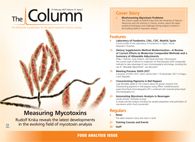Chromatographers Find Value in Food Waste
The disposal of food waste can pose serious environmental problems. Food scraps from the kitchen often end up in landfill, where it rots and produces methane, a greenhouse gas.
Photo Credit: Velychko/Shutterstock.com

The disposal of food waste can pose serious environmental problems. Food scraps from the kitchen often end up in landfill, where it rots and produces methane, a greenhouse gas.
A group of researchers from India have chemically characterized food waste using gas chromatography coupled to mass spectrometry (GC–MS) and GC with flame ionization detection (GC–FID) and identified possible reuse and disposal techniques (1). Food waste samples were collected from the kitchen of a girls’ hostel at the National Institute of Technology, in Rourkela, India. Food waste samples were collected, dried and the samples used for lipid extraction. A variety of different times and a variety of different solvent to food waste volumes were performed to analyze the lipid profile of the food waste samples.
GC–MS and GC–FID were performed to identify and quantify the presence of organic compounds in lipids from food waste. Caproic acid (6:1), lauric acid (12:0), mystric acid (14:0), palmitic acid (16:0), stearic acid (17:0), and oleic acid (18:0) were identified using GC–MS. Palmitic acid (60.89 mg/L), stearic acid (74.11 mg/L), and oleic acid (3.81 mg/L) dominated the lipid profile.
The team concluded that kitchen food waste could potentially be raw material for biodiesel production, as an alternative to fossil diesel. In addition, calcium (20.36 mg/L), iron (30.84 mg/L), magnesium (3.00 mg/L), and chromium (1.28 mg/L) were also identified. These metals could possibly be extracted and used in the pharmaceutical and agricultural industries, according to the researchers. - K.M.
Reference
- Sipra Barik and Kakoli Karar Paul, Journal of Environmental Chemical Engineering 5(1), 196–204 (2017).

Analytical Challenges in Measuring Migration from Food Contact Materials
November 2nd 2015Food contact materials contain low molecular weight additives and processing aids which can migrate into foods leading to trace levels of contamination. Food safety is ensured through regulations, comprising compositional controls and migration limits, which present a significant analytical challenge to the food industry to ensure compliance and demonstrate due diligence. Of the various analytical approaches, LC-MS/MS has proved to be an essential tool in monitoring migration of target compounds into foods, and more sophisticated approaches such as LC-high resolution MS (Orbitrap) are being increasingly used for untargeted analysis to monitor non-intentionally added substances. This podcast will provide an overview to this area, illustrated with various applications showing current approaches being employed.










